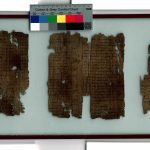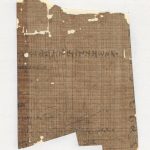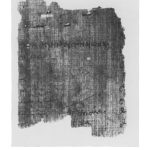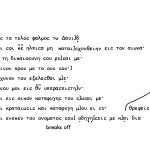| Artefact ID | 728 |
| TM ID | TM 62009 |
| Findspot (DEChriM ID) | 30 (al-Ašmūnayn) | Class | Textual |
| Material | Papyrus |
| Writing medium | Sheet/roll |
| Text content | Subliterary |
| Language | Greek |
| Description | Emmenegger 2007: 328-370; Aland AT59 Fragments from a papyrus roll containing Psalms 30-55. The two fragments (P.Lips.Inv. 39 V + P.Bonn.Inv. 147 V) were reunited after the suggestion of Rahlfs / Fraenkel; see Colomo / Scholl 2005: 162. The Leipzig papyrus roll is almost completely intact, and measures 396 cm long and ca. 28 cm high. The verso was first published by C. Heinrici in 1903. The recto presents a documentary text, and is published as P.Lips. I 97 (an account from 338; Hermoupolis). The Psalms were written 'upside-down' from the documentary text, meaning that the first psalm (Ps 30) began on the back of the first column of the recto. The Leipzig roll preserves 34 columns (of originally 36) with liturgical text arranged in approx. 30-33 lines per column. As the columns are more numerous than their counterparts on the recto, they do not follow the same arrangement in relation to the kollemata. The average column width is approx. 10-15 cm; see ref. ed. The Bonn-fragment measures 5.8 x 7.5 cm, and contains Psalm 30 (31). 1-4. It was dated to the late 3rd/ 4th c. by the ed. pr. (Shelton). The fragment belongs to columns i and ii of the Leipzig-roll, and thus it becomes apparent that the liturgical roll began with Psalm 30. Line-division is stichometric. The beginning of a new Psalm is marked by a paragraphos, eisthesis, and a T-shaped symbol above the first line. Short lines are inserted superlinearly and most often marked by a 'hook'. The text contains rough breathings, irregular diaereses and diastoles, and the obelos appears thrice (in 37:9, 38:43 and 39:31). Only the latter obelos is a known insertion. Several corrections have been made by the same hand. The script is described as a quick cursive, with a scribal idiosyncracy of writing as long as possible before redipping into the ink; see ed. pr. (Heinrici). |
| Selection criteria | Subliterary genre (Liturgical), Nomina sacra |
| Date from | 338 |
| Date to | 399 |
| Dating criteria | Palaeography as well as internal evidence: the Psalms are written on a volumen which already contained a document written in 338 AD, providing a terminus post quem. Palaeographical assessments place the liturgical fragment in the 4th c.; see ed. pr. |
| Absolute/relative date | Relative date |
| Archaeological context | The provenance is Hermoupolis Magna (al-Ašmūnayn); see Colomo / Scholl 2005: 162. Part of the fragments were acquired by Otto Rubensohn from box 6 of the Papyrus Fund in August 1902; in 1909, it was transferred to the Royal Saxon Society of Sciences and it is now kept in the Leipzig University Library as part of P.Lips. inv. 39 V. |
| Accession number | Bonn, Universitäts- und Landesbibliothek 147 (verso) as well as Leipzig, Universität 39 (verso) |
ARTEFACT IDENTIFIERS
Reference edition:
• Emmenegger, Gregor. 2007. Der Text des koptischen Psalters aus al-Mudil. Texte und Untersuchungen zur Geschichte der altchristlichen Literatur 159. De Gruyter. 328-370.
Editiones principes:
• Heinrici, Carl Friedrich Georg. 1903. Die Leipziger Papyrus-fragmente der Psalmen. Beiträge zur Geschichte und Erklärung des Neuen Testaments 4. Leipzig. (Leipzig-fragment)
• Shelton, John C. 1977. "Papyri from the Bonn Collection". Zeitschrift für Papyrologie und Epigraphik 25. 159-183: 160-161, papyrus no. 1 and plate Va. (Bonn-fragment)
Additional bibliography:
• Aland, Kurt. 1976. Repertorium der griechischen christlichen Papyri: 1. Biblische Papyri: Altes Testament, Neues Testament, Varia, Apokryphen. Altes Testament 59.
• Colomo, Daniela and Reinhold Scholl. 2005. "Psalmen und Rechnungen: P.Bonn. Inv. 147 + P.Lips. I 97". Zeitschrift für Papyrologie und Epigraphik 153. 163-167.
• Rahlfs, Alfred and Detlef Fraenkel. 2004 (1914). Verzeichnis der griechischen Handschriften des Alten Testaments. Göttingen. 45-46 and 193-194, descr. no. 2013.
• van Haelst, Joseph. 1976. Catalogue des papyrus littéraires juifs et chrétiens. Paris. Description no. 133.


 Json data
Json data







